

Ayman al-Zawahiri. Ayman Mohammed Rabie al-Zawahiri[2] (Arabic: أيمن محمد ربيع الظواهري ʾAyman Muḥammad Rabīʿ aẓ-Ẓawāhirī, born June 19, 1951) is an Egyptian physician,[3] Islamic theologian and current leader of the militant Islamist organization al-Qaeda.[4] Ayman al-Zawahiri is a former member of Islamist organizations which have both orchestrated and carried out multiple attacks on the continents of North America, Asia, Africa and the Middle East.
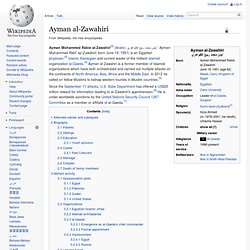
In 2012 he called on fellow Muslims to kidnap western tourists in Muslim countries.[5] Since the September 11 attacks, U.S. State Department has offered a US$25 million reward for information leading to al-Zawahiri's apprehension.[6] He is under worldwide sanctions by the United Nations Security Council 1267 Committee as a member or affiliate of al-Qaeda.[7]
THE OPTIMAL SIZE OF A TERRORIST NETWORK. Distributed, dynamic terrorist networks cannot scale like hierarchical networks.
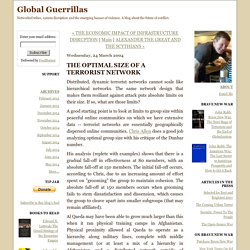
The same network design that makes them resiliant against attack puts absolute limits on their size. If so, what are those limits? A good starting point is to look at limits to group size within peaceful online communities on which we have extensive data -- terrorist networks are essentially geographically dispersed online communities.
Chris Allen does a good job analyzing optimal group size with his critique of the Dunbar number. His analysis (replete with examples) shows that there is a gradual fall-off in effectiveness at 80 members, with an absolute fall-off at 150 members. Al Qaeda may have been able to grow much larger than this when it ran physical training camps in Afghanistan. This leads us to optimal group size, which according to Chris Allen's online group analysis, can be seen at two levels: both small and medium sized. This size dynamic can also be seen in criminal organizations. AL QAEDA'S GRAND STRATEGY: SUPERPOWER BAITING. What is al Qaeda's grand strategy?
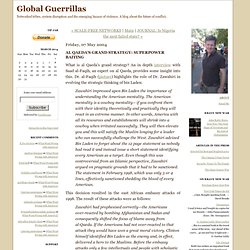
An in depth interview with Saad al-Faqih, an expert on al Qaeda, provides some insight into this. Dr. al-Faqih (picture) highlights the role of Dr. Zawahiri in evolving the strategic thinking of bin Laden: Zawahiri impressed upon Bin Laden the importance of understanding the American mentality. The American mentality is a cowboy mentality-- if you confront them with their identity theoretically and practically they will react in an extreme manner. This decision resulted in the east African embassy attacks of 1998. BBC now admits al qaeda never existed.
Mapping Militant Organizations. Narrative Summary Al-Qaeda (AQ) is one of the longest-operating jihadist militant organizations in the Middle East and Asia, with followers and support around the world.
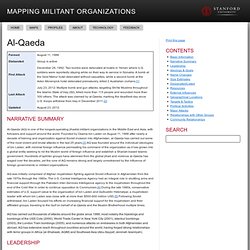
Founded by Osama bin Laden on August 11, 1988 after nearly a decade of training and organization against Soviet invasion into Afghanistan, al-Qaeda has carried out some of the most violent and brutal attacks in the last 25 years. AQ was founded around the individual ideologies of bin Laden, with minimal foreign influence permeating his command of the organization as it has grown into a global entity seeking to rid the Muslim world of foreign influence and establish a Shariah-based Islamic government. Hundreds of splinter groups have stemmed from the global jihad and violence al-Qaeda has waged over the decades, yet the core of AQ remains strong and largely unrestrained by the influence of foreign governments or militant organizations. Al-Qa‘ida - Terrorist Groups. Al-Qa‘ida Established by Usama Bin Ladin in 1988 with Arabs who fought in Afghanistan against the Soviet Union, al-Qa‘ida’s declared goal is the establishment of a pan-Islamic caliphate throughout the Muslim world.
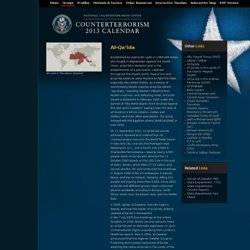
Toward this end, al-Qa‘ida seeks to unite Muslims to fight the West, especially the United States, as a means of overthrowing Muslim regimes al-Qa‘ida deems “apostate,” expelling Western influence from Muslim countries, and defeating Israel. Al-Qa‘ida issued a statement in February 1998 under the banner of “the World Islamic Front for Jihad Against the Jews and Crusaders” saying it was the duty of all Muslims to kill US citizens—civilian and military—and their allies everywhere.
The group merged with the Egyptian Islamic Jihad (al-Jihad) in June 2001. Al-Qaeda. Al-Qaeda around the world.
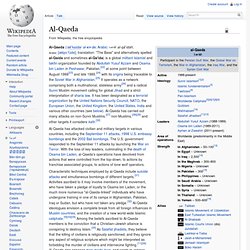
Al-Qaeda (/ælˈkaɪdə/ al-KY-də; Arabic: القاعدة al-qāʿidah, Arabic: [ælqɑːʕɪdɐ], translation: "The Base" and alternatively spelled al-Qaida and sometimes al-Qa'ida) is a global militant Islamist and takfiri organization founded by Abdullah Yusuf Azzam and Osama bin Laden in Peshawar, Pakistan,[22] at some point between August 1988[23] and late 1989,[24] with its origins being traceable to the Soviet War in Afghanistan.[25] It operates as a network comprising both a multinational, stateless army[26] and a radical Sunni Muslim movement calling for global Jihad and a strict interpretation of sharia law.
It has been designated as a terrorist organization by the United Nations Security Council, NATO, the European Union, the United Kingdom, the United States, India and various other countries (see below).